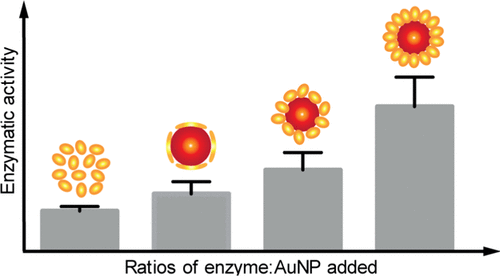Our official English website, www.x-mol.net, welcomes your feedback! (Note: you will need to create a separate account there.)
Molecular Crowding and a Minimal Footprint at a Gold Nanoparticle Support Stabilize Glucose Oxidase and Boost Its Activity.
Langmuir ( IF 3.9 ) Pub Date : 2020-01-03 , DOI: 10.1021/acs.langmuir.9b02863 Yuanmo Wang 1 , Rima Jonkute 1 , Hampus Lindmark 1 , Jacqueline D Keighron 2 , Ann-Sofie Cans 1
Langmuir ( IF 3.9 ) Pub Date : 2020-01-03 , DOI: 10.1021/acs.langmuir.9b02863 Yuanmo Wang 1 , Rima Jonkute 1 , Hampus Lindmark 1 , Jacqueline D Keighron 2 , Ann-Sofie Cans 1
Affiliation

|
Enzymes conjugated to nanomaterials are used in the design of various biotechnologies. In the development of biosensors, surface modifications with the enzyme glucose oxidase (GOx) serve to aid the detection of blood glucose. In order to optimize sensor effectiveness, the enzyme tertiary structure needs to be preserved upon immobilization to retain the enzyme's catalytic activity. Because of the nature of GOx, it suffers from a tendency to denature when immobilized at a solid surface; hence, methods to optimize enzyme stability are of great importance. Here, we introduce the study of the interaction of GOx to the highly curved surface of 20 nm gold nanoparticles (AuNP) with an absorbed monolayer coating of enzyme as determined by flocculation assays and quantification of immobilized GOx at the nanoparticle surface. Enzyme crowding was determined by comparing the number of enzymes that bind to how many can physically fit. These measurements show how placing a monolayer of enzyme where the enzyme spreads thin at the AuNP surface still provides stable catalytic performance of up to 14 days compared to enzymes free in solution. Moreover, by the increasing enzyme density via increasing the amount of GOx present in solution during the GOx/AuNP conjugation step creates a molecularly crowded environment at the highly curved nanoparticle surface. This limits the size of the enzyme footprint for attachment and shows that the activity per enzyme can be enhanced up to 300%. This is of great importance for implementing stable and sensitive sensor technologies that are constructed by enzyme-based nanoparticle scaffolds. Here, we show by using the conditions that maintain GOx structure and function when limiting the enzyme coating to an ultrathin layer, the design and construction of an ultrafast responding diagnostic sensor technology for glucose can be achieved, which is crucial for monitoring rapid fluctuations of, for instance, glucose in the brain.
中文翻译:

分子拥挤和最小的足迹在金纳米粒子支持稳定葡萄糖氧化酶并提高其活性。
与纳米材料结合的酶被用于各种生物技术的设计中。在生物传感器的开发中,用葡萄糖氧化酶(GOx)进行的表面修饰有助于检测血糖。为了优化传感器的有效性,固定后需要保留酶的三级结构以保持酶的催化活性。由于GOx的性质,当固定在固体表面上时,它会发生变性的趋势。因此,优化酶稳定性的方法非常重要。在这里,我们介绍了通过絮凝测定法和定量的固定化GOx在纳米颗粒表面上对GOx与20 nm金纳米颗粒(AuNP)的高度弯曲表面与吸收的单层酶涂层相互作用的研究。酶拥挤是通过比较结合多少酶才能适应的酶的数量来确定的。这些测量结果表明,与在溶液中游离的酶相比,在酶在AuNP表面稀薄分布的单层酶上如何仍能提供长达14天的稳定催化性能。此外,通过在GOx / AuNP共轭步骤期间通过增加溶液中存在的GOx的量来增加酶密度,在高度弯曲的纳米颗粒表面上形成了分子拥挤的环境。这限制了用于附着的酶足迹的大小,并且表明每种酶的活性可以提高至300%。这对于实施由基于酶的纳米颗粒支架构建的稳定而灵敏的传感器技术至关重要。这里,
更新日期:2020-01-04
中文翻译:

分子拥挤和最小的足迹在金纳米粒子支持稳定葡萄糖氧化酶并提高其活性。
与纳米材料结合的酶被用于各种生物技术的设计中。在生物传感器的开发中,用葡萄糖氧化酶(GOx)进行的表面修饰有助于检测血糖。为了优化传感器的有效性,固定后需要保留酶的三级结构以保持酶的催化活性。由于GOx的性质,当固定在固体表面上时,它会发生变性的趋势。因此,优化酶稳定性的方法非常重要。在这里,我们介绍了通过絮凝测定法和定量的固定化GOx在纳米颗粒表面上对GOx与20 nm金纳米颗粒(AuNP)的高度弯曲表面与吸收的单层酶涂层相互作用的研究。酶拥挤是通过比较结合多少酶才能适应的酶的数量来确定的。这些测量结果表明,与在溶液中游离的酶相比,在酶在AuNP表面稀薄分布的单层酶上如何仍能提供长达14天的稳定催化性能。此外,通过在GOx / AuNP共轭步骤期间通过增加溶液中存在的GOx的量来增加酶密度,在高度弯曲的纳米颗粒表面上形成了分子拥挤的环境。这限制了用于附着的酶足迹的大小,并且表明每种酶的活性可以提高至300%。这对于实施由基于酶的纳米颗粒支架构建的稳定而灵敏的传感器技术至关重要。这里,



























 京公网安备 11010802027423号
京公网安备 11010802027423号